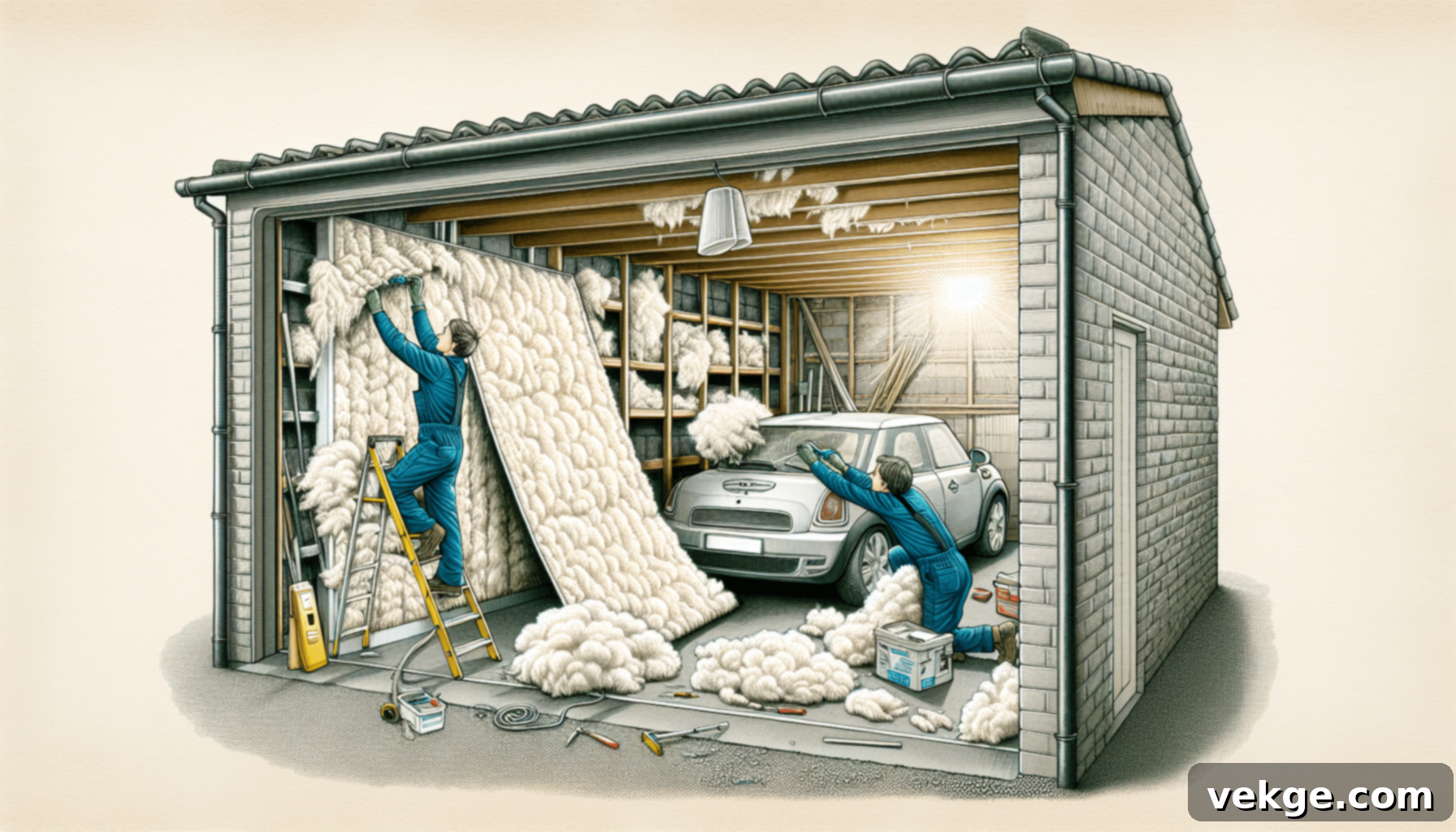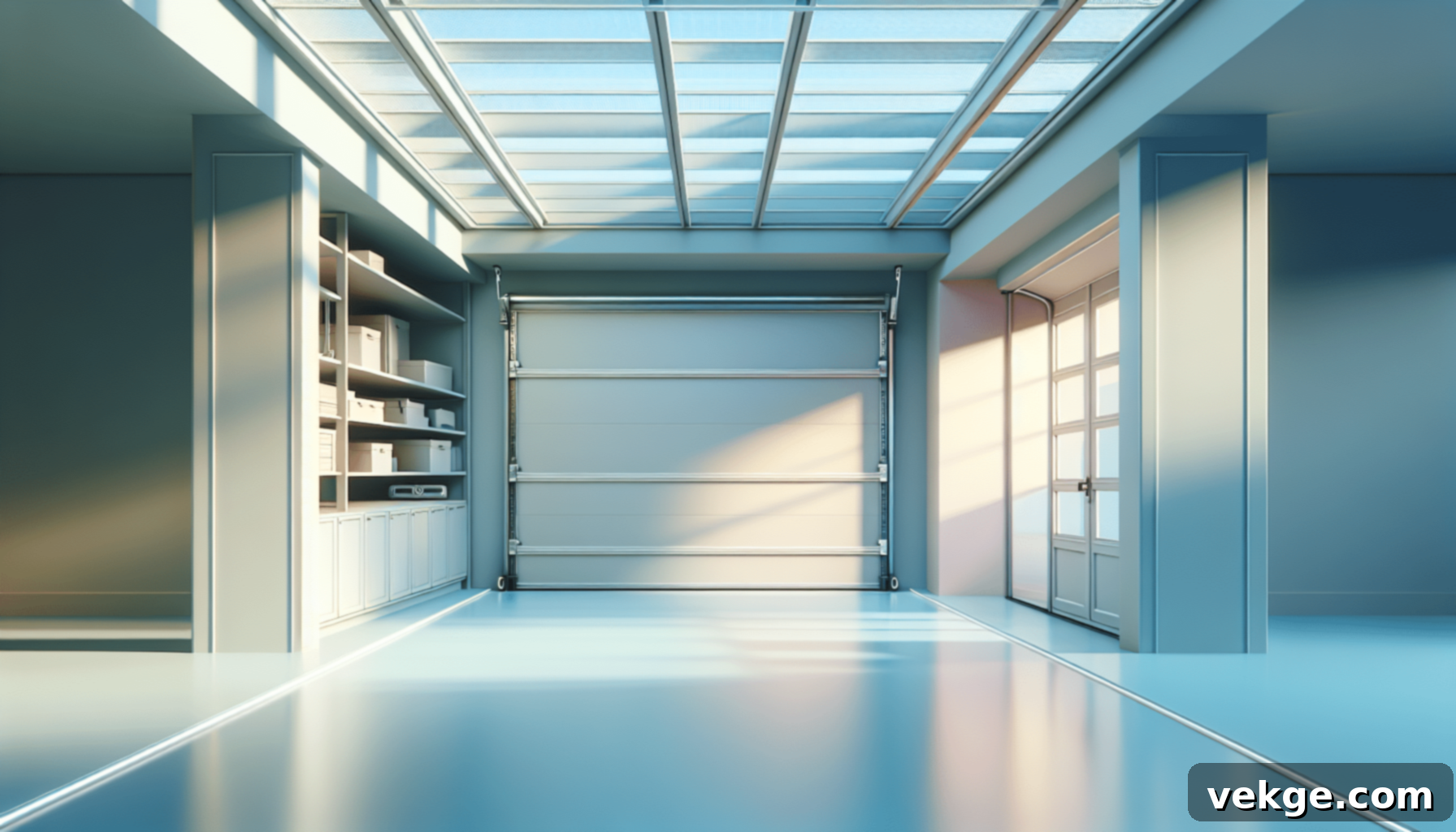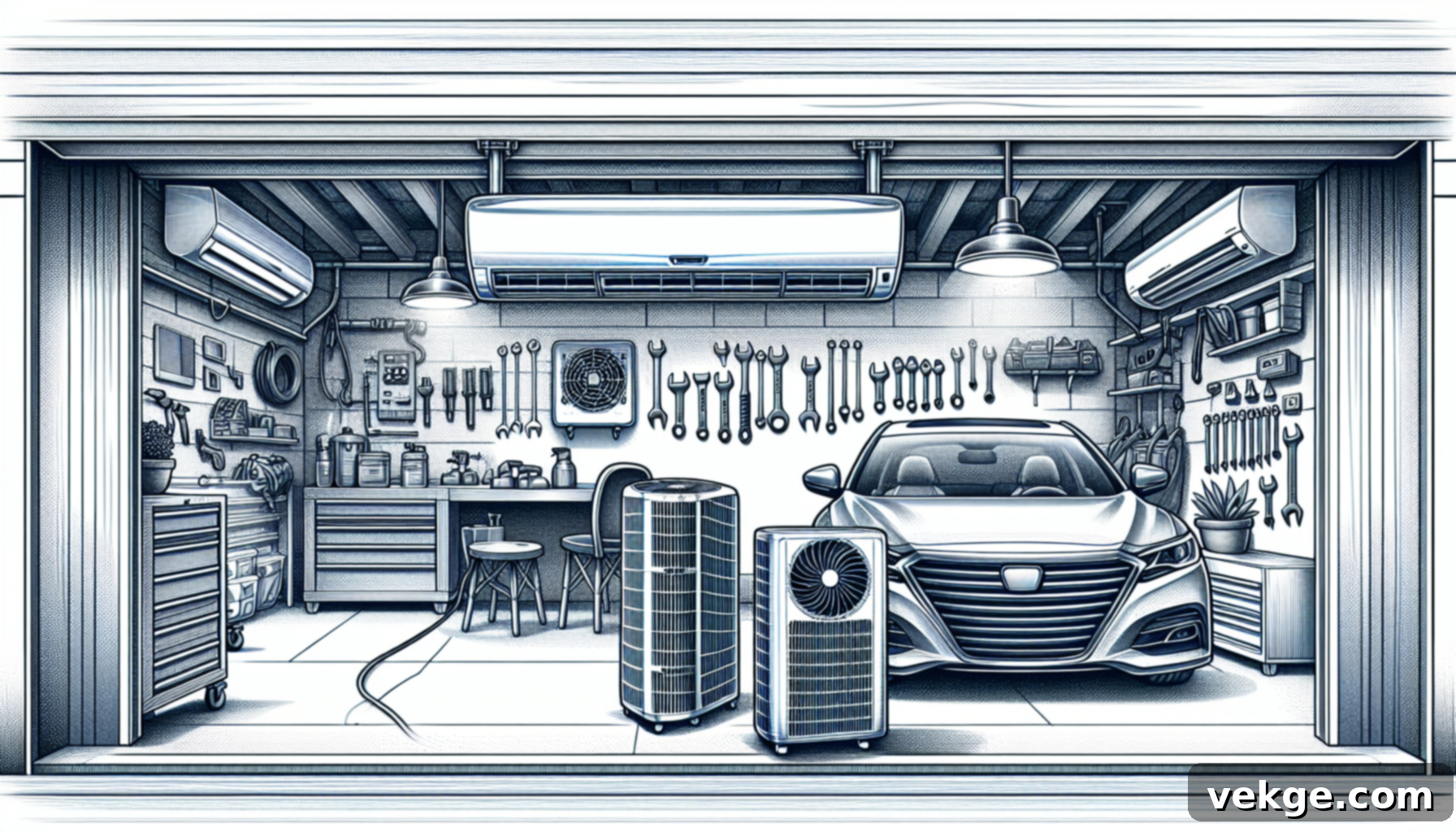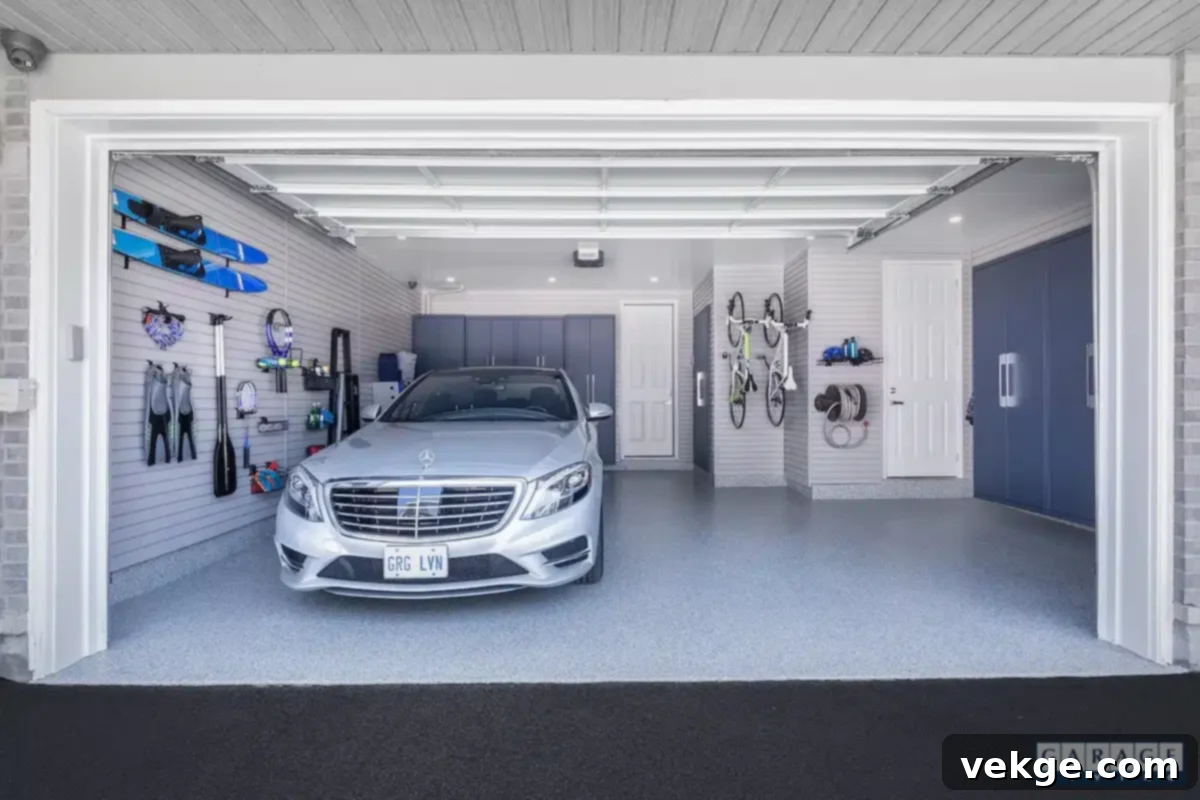The Ultimate Guide to Cooling Your Garage: Beat the Heat and Boost Comfort
Is your garage a sweltering oven during warmer months? A scorching hot garage is more than just an annoyance; it can make your projects unbearable, damage stored items, and even impact the energy efficiency of your home. If you’re tired of stepping into an uncomfortably warm space, this comprehensive guide offers a range of effective cooling techniques to transform your garage into a comfortable, functional area. From ingenious natural ventilation tricks to sophisticated cooling systems, we’ll equip you with all the knowledge you need to achieve optimal garage temperature control without any unnecessary fluff or overwhelming jargon.
Key Strategies for a Cooler Garage
- **Optimize Airflow:** Implement strategic fan placement, enhance natural cross-ventilation, and consider active ventilation systems to efficiently move hot air out and draw cooler air in.
- **Invest in Insulation:** Properly insulate your garage’s roof, walls, and doors, and seal air leaks with weatherstripping to significantly reduce heat transfer and maintain stable temperatures.
- **Smart Shading Solutions:** Utilize awnings, strategic landscaping, or reflective paints to block direct sunlight and prevent heat buildup before it even enters your garage.
- **Advanced Cooling & Dehumidification:** Explore options like portable air coolers, dehumidifiers, or dedicated air conditioning systems (including mini-splits) for superior comfort in any climate.
Maximizing Air Circulation: The Foundation of Garage Cooling

The first step toward a significantly cooler garage is ensuring excellent air circulation. Imagine opening your garage door to a refreshing breeze instead of a stifling wave of heat. Achieving this comfortable environment requires a multi-pronged approach: optimizing fan placement, leveraging natural ventilation, and considering robust active ventilation systems. By effectively moving air, you can prevent heat from stagnating and create a noticeably cooler atmosphere.
Optimal Placement of Fans for Maximum Effect
Fans are indispensable tools for circulating air and expelling hot pockets from your garage. Various types, including box fans, pedestal fans, and ceiling fans, can be highly effective. The key, however, lies in their strategic positioning. For ceiling fans, ensure their blades are ideally situated 7 to 9 feet above the floor and 10 to 12 inches below the ceiling. This placement maximizes their ability to push air downward and outward, creating a broader cooling effect.
For standalone fans, consider creating a cross-ventilation effect. Place one fan near an open window or the main garage door facing inward to draw cooler air in, and another fan facing outward near an opposite opening to push hot air out. This creates a powerful airflow current that can rapidly lower the garage’s ambient temperature.
Enhancing Natural Ventilation with Smart Design
Don’t underestimate the power of Mother Nature. By enhancing natural ventilation, you can significantly improve airflow and reduce heat buildup without relying solely on powered devices. Installing roof vents or gable vents is an excellent starting point. These passive systems create an escape route for rising hot air, allowing cooler, denser air to be drawn in from lower areas, such as through the main garage door or smaller ground-level vents. This convection process naturally flushes out heat.
Furthermore, consider adding strategically placed foundation vents or even leaving a small gap at the bottom of your garage door to encourage air intake. During cooler parts of the day, particularly mornings or evenings, opening the main garage door and any windows can provide a rapid and refreshing flush of fresh air. Consistent natural airflow is crucial for preventing heat from becoming trapped inside your garage.
Implementing Active Ventilation Systems for Superior Cooling
For those seeking superior and more consistent cooling, active ventilation systems are highly recommended. Unlike passive methods, these systems actively increase air circulation and remove trapped hot air, making your garage significantly more comfortable and cooler. They work more effectively than simply opening doors, especially in still air conditions.
A popular and efficient option is an attic fan equipped with a built-in thermostat. This intelligent device automatically activates when the garage or attic temperature reaches a pre-set level, powerfully expelling hot air. By continuously exhausting stagnant hot air, an attic fan prevents heat from radiating into your garage space below, thereby reducing the overall garage temperature and making other cooling efforts more efficient. This proactive approach ensures your garage stays cooler, smarter, and with less effort.
Insulating Your Garage: The Key to Stable Temperature Control

Once you’ve mastered air circulation, the next crucial step is insulation. Think of insulation as your garage’s protective shield, working tirelessly to prevent unwanted heat from entering (or escaping in winter). Proper insulation acts as a thermal barrier, significantly reducing heat transfer through the building envelope. The primary areas to focus on for effective insulation include the roof, walls, and especially the garage door.
Understanding insulation materials, sealing air leaks, and considering insulated door upgrades are vital components of a truly temperature-controlled garage environment. Let’s delve into these critical aspects in more detail.
Choosing the Right Insulation Material for Your Garage
Selecting the appropriate insulation material is paramount for effective heat reduction. Several popular options are available, each with distinct benefits:
- **Fiberglass Insulation:** Common and cost-effective, available in batts or rolls. It’s excellent for wall cavities and ceilings, offering good thermal resistance (R-value).
- **Foam Boards:** Materials like expanded polystyrene (EPS), extruded polystyrene (XPS), and polyisocyanurate (polyiso) offer higher R-values per inch than fiberglass. They are rigid, easy to install on walls and garage doors, and resistant to moisture.
- **Spray Foam Insulation:** Provides an excellent air seal and high R-value, filling irregular spaces perfectly. However, it’s typically more expensive and requires professional installation.
- **Reflective Barriers:** These are not insulation in the traditional sense but are highly effective at reflecting radiant heat. Often installed in attics or on garage doors, they bounce solar radiation away, preventing it from penetrating the structure.
When choosing, consider factors like your local climate, the R-value requirements, ease of installation, and your budget to find the best fit for your garage.
Weatherproofing Garage Doors and Windows: Sealing the Heat Out
Even the best insulation can be undermined by air leaks. Gaps around garage doors and windows act like open invitations for hot air to infiltrate your space, making your garage feel like a sauna. Addressing these leaks is a cost-effective way to improve thermal performance dramatically.
- **Caulking:** Use high-quality exterior caulk to seal any cracks or gaps around window frames and door jambs. This creates an airtight seal that prevents air infiltration.
- **Weatherstripping:** Install new vinyl or rubber weatherstripping around the perimeter of your garage door and windows. Pay particular attention to the bottom seal of the garage door, as this is a common culprit for drafts and heat entry. High-quality weatherstripping forms a tight barrier against external temperatures, dust, and moisture.
By thoroughly weatherproofing your garage, you’re essentially giving unwanted heat the “cold shoulder,” ensuring that your cooling efforts are not wasted on air seeping through unnoticed openings.
Upgrading to Insulated Garage Doors for Enhanced Comfort
If your garage door is old, thin, or lacks any insulation, upgrading to an insulated model is one of the most impactful improvements you can make. Insulated garage doors are constructed with layers of insulating material (like polystyrene or polyurethane foam) sandwiched between steel or other robust panels. This design provides exceptional thermal resistance, significantly reducing heat transfer from the outside.
Not only do insulated doors protect your garage from extreme external temperatures, but they also contribute to a more moderate interior climate, offering better noise reduction and increased durability. It’s like giving your garage its very own climate-controlled protective layer, making it much easier to maintain a comfortable air temperature throughout the year.
Smart Shading Strategies: Keeping the Sun’s Heat at Bay

Prevention is often the best cure, and this adage certainly applies to keeping your garage cool. One of the most effective ways to prevent heat buildup is by implementing smart shading strategies that block direct sunlight before it can heat up your garage walls and roof. These methods include installing awnings or canopies, strategically using landscaping, and applying specialized reflective paints and coatings. By intercepting solar radiation, you can significantly reduce the solar heat gain within your garage.
Installing Awnings or Canopies for Direct Shade
Awnings and canopies act like natural sunglasses for your garage, providing a direct physical barrier against the sun’s intense rays. They are particularly effective for south or west-facing garage doors and windows, which receive the most direct sunlight. There are several types to consider:
- **Retractable Awnings:** Offer flexibility, allowing you to extend them for shade when needed and retract them during cloudy days or cooler seasons, or when you prefer full sunlight.
- **Motorized Awnings:** Provide the ultimate convenience with remote-controlled operation, making adjustment effortless.
- **Stationary Awnings:** A permanent solution that provides consistent shade year-round. They are robust and require minimal maintenance.
- **Freestanding Canopies:** Separate structures that can provide shade over a larger area, such as a driveway section adjacent to the garage.
Choosing the right awning depends on your budget, aesthetic preferences, and the degree of flexibility you require for shade management. Regardless of the type, they are highly effective at reducing the heat load on your garage exterior.
Landscaping for Natural Cooler Air and Shade
Harnessing the power of nature through strategic landscaping is both aesthetically pleasing and highly functional for garage cooling. Planting deciduous trees on the sunniest sides of your garage can provide significant shade during the hot summer months. Species like the paper birch, tulip poplar, maple, or oak are excellent choices, growing large enough to cast broad shadows.
During the summer, their dense foliage blocks solar radiation, keeping your garage cooler. In winter, after their leaves fall, they allow sunlight to warm the garage naturally. This seasonal sun control is an eco-friendly and sustainable way to manage garage temperatures, and it adds curb appeal to your home. Consider also planting shrubs or building trellises with climbing vines to shade specific walls.
Reflective Paints and Coatings for Radiant Heat Deflection
Reflective paints and coatings work like a mirror, deflecting sunlight and its associated heat away from your garage’s surfaces. By preventing the absorption of solar radiation, these specialized products can significantly reduce the surface temperature of your garage walls and roof, which in turn reduces the amount of heat transferred inside.
- **Elastomeric Coatings:** These highly flexible coatings often contain ceramic microspheres that reflect sunlight and help seal small cracks, providing both reflectivity and weather protection.
- **Ceramic Paints:** Infused with microscopic ceramic particles, these paints help reflect heat and improve insulation properties when applied to exterior walls and roofs.
- **Light-Colored Paints:** Simply choosing white or very light-colored paints for your garage door, exterior walls, and roof can make a substantial difference, as lighter colors naturally absorb less heat than darker ones.
Applying such coatings is a relatively simple yet highly effective way to keep your garage cooler without compromising its appearance, offering a proactive approach to heat management.
The Underrated Role of Dehumidifiers in Garage Cooling
In humid climates, a dehumidifier is an unsung hero in the battle against a hot, stuffy garage. While they don’t directly lower the air temperature, they significantly improve perceived comfort. By extracting excess water vapor from the air, dehumidifiers reduce the ‘sticky’ or ‘muggy’ feeling associated with high humidity. When humidity is high, your body’s natural cooling mechanism (sweating) becomes less effective, making you feel hotter than the actual temperature. A drier environment allows sweat to evaporate more readily, making the air feel inherently cooler and more pleasant.
Modern dehumidifiers often come with smart features, like built-in humidistats, allowing you to set a desired humidity level (e.g., 50-60%). Devices like the Cielo Breez can even integrate with smart home systems, offering remote control and automated operation to efficiently maintain optimal humidity levels. This not only enhances comfort but also helps protect tools, equipment, and other stored items from moisture damage, rust, and mildew.
Utilizing Color and Clutter Management for a Cooler Space

While seemingly simple, your garage’s interior color scheme and level of organization can have a noticeable impact on its temperature. Lighter colors can reflect ambient light and heat, contributing to a cooler feel, while an organized, clutter-free space facilitates better air movement and prevents heat traps. These are often overlooked but effective strategies for enhancing garage comfort.
Lighter Colors for Optimal Heat Reflection
When planning your garage’s interior or exterior, color choice matters. Darker colors absorb more solar radiation and heat, while lighter colors reflect it. To minimize heat absorption and keep your garage cooler:
- **Interior Walls:** Opt for white, off-white, light gray, or cream shades for your garage walls. These colors reflect light more efficiently, making the space feel brighter and cooler.
- **Garage Door & Exterior Walls:** If repainting the exterior, choose light colors for the garage door and any exposed walls. For durability and better reflective properties, consider water-based latex paint with mildewcides, which can also withstand temperature fluctuations better.
- **Ceiling:** A white ceiling is always recommended to reflect light and heat downward, preventing heat from radiating back into the space.
Making conscious color choices is a simple yet effective way to passively reduce the heat load on your garage.
Decluttering for Improved Air Flow and Reduced Heat Traps
A cluttered garage isn’t just an eyesore; it’s also a breeding ground for trapped heat. Piles of boxes, tools, and stored items can significantly obstruct airflow pathways, creating dead air zones and hot spots where heat can accumulate. This reduces the overall efficiency of any ventilation or cooling system you have in place, making your garage feel warmer than it needs to be.
Implementing effective organization strategies is crucial. Install wall-mounted cabinets, shelving units, pegboards, and overhead storage racks to get items off the floor and away from walls. This not only frees up floor space but also allows air to circulate more freely throughout the entire garage, enhancing the effectiveness of fans and ventilation systems. A tidy garage is inherently a cooler garage, as it promotes unhindered air movement and reduces thermal mass that can absorb and radiate heat.
Portable Cooling Solutions: Evaporative Coolers and Portable AC Units
Portable air coolers and portable air conditioning units offer flexible and immediate relief from summer heat, especially for garages where permanent installations might be impractical or too costly. Devices like Evapolar (an evaporative cooler) are excellent for personal cooling or smaller, well-ventilated spaces.
- **Evaporative Coolers (Swamp Coolers):** These units work by drawing in hot, dry air over water-saturated pads. The water evaporates, absorbing heat from the air and releasing cooler, moistened air. They are most effective in arid climates with low humidity, where they can significantly drop the temperature. They are energy-efficient and add moisture to the air, which can be a benefit in dry regions.
- **Portable Air Conditioners:** These units function similarly to traditional ACs but are self-contained and movable. They pull in hot air, cool it using a refrigerant, and exhaust the hot air through a hose vented out a window or small opening. They are effective in both humid and dry climates and provide more substantial cooling than evaporative coolers, though they consume more electricity.
Both options provide convenient, on-demand cooling that can be moved wherever you need it most in your garage, making them ideal for workbenches, specific project areas, or temporary cooling needs.
Advanced Cooling Solutions: Air Conditioning and Mini-Splits

For ultimate comfort and consistent temperature control, dedicated air conditioning systems are the pinnacle of garage cooling. These solutions offer powerful and efficient cooling, transforming your garage into a truly livable or workable space regardless of the external weather conditions. Options include ductless mini-splits, window air conditioners, and through-the-wall air conditioners. These systems provide a significant upgrade over basic ventilation and insulation alone.
Selecting the Appropriate Air Conditioner for Your Garage
Choosing the right type of air conditioner is critical for effective and efficient garage cooling. Consider the size of your garage (measured in square feet) to determine the appropriate British Thermal Unit (BTU) rating needed. A unit that is too small won’t cool effectively, while one that is too large will cycle on and off too frequently, leading to inefficiency and humidity issues.
- **Ductless Mini-Split Air Conditioner Units:** These are often the top choice for average-sized garages (typically 1-3 car garages). They consist of an outdoor compressor/condenser and one or more indoor air-handling units. They are highly energy-efficient, quiet, and offer zoned cooling, meaning you only cool the space you’re using. They don’t require ductwork, making installation simpler than central AC.
- **Through-the-Wall Air Conditioners:** Similar to window units but designed for permanent installation through an exterior wall. They offer a clean look, are known for being quiet, highly efficient, and capable of cooling spaces rapidly. They are a good alternative if window space is limited or undesirable.
- **Window Air Conditioners:** A more budget-friendly and easy-to-install option. While effective, they occupy window space and may not be as aesthetically pleasing or secure as other options.
Assessment of your garage’s specific dimensions, insulation levels, and your budget will help you select the best fit for optimal cooling performance.
Benefits of Mini-Split Systems for Garage Environments
Mini-split systems offer several distinct advantages that make them particularly well-suited for garage cooling:
- **Energy Efficiency:** They are highly energy-efficient, often boasting high SEER (Seasonal Energy Efficiency Ratio) ratings. Their ductless design minimizes energy loss associated with traditional ducted systems.
- **Flexible Installation:** They do not require extensive ductwork or windows for installation, offering greater flexibility in placement. The indoor unit can be mounted on a wall or ceiling, making them ideal for garages lacking sufficient window space or for those who prefer a cleaner look.
- **Quiet Operation:** Both the indoor and outdoor units operate quietly, ensuring a peaceful environment in your garage.
- **Heating and Cooling:** Many mini-split units are also heat pumps, providing both cooling in summer and heating in winter, making your garage comfortable year-round.
- **Zoned Comfort:** If you have a larger garage or specific areas you want to cool more intensely, multi-zone mini-splits allow for individual temperature control in different sections.
If you’re looking for an efficient, versatile, and comprehensive way to maintain a comfortable temperature in your garage, a mini-split system is an excellent long-term investment.
Seasonal Adjustments for Maintaining a Cool Garage
Maintaining a cool garage isn’t a one-time effort; it requires dynamic adjustments based on the changing seasons and daily conditions. By adapting your strategies, you can significantly enhance your garage’s comfort and efficiency, even if it’s just by a few degrees. These small changes can make a world of difference.
- **During Peak Heat Hours:** Keep your garage door closed during the hottest parts of the day. This prevents direct sunlight and scorching outside air from entering and raising the interior temperature.
- **Leverage Cooler Air:** Open the garage door and any windows during cooler morning hours or in the evening once the sun has set. Allow the cooler night air or morning breeze to flush out any accumulated heat and refresh the space.
- **Hot Car Management:** If you’ve just driven your car on a hot day, consider parking it outside for a short period to allow the engine and exhaust heat to dissipate before parking it inside. A recently driven hot car can significantly contribute to heat buildup in an enclosed garage.
- **Use Fans Strategically:** During cooler evenings, use fans to draw cool outdoor air in and push warmer indoor air out. Create a cross-ventilation path to maximize effectiveness.
By being mindful of external temperatures and making these seasonal and daily adjustments, you can proactively manage your garage’s climate and enhance its overall comfort.
Creative Alternatives for a Cool Garage Experience
Beyond traditional methods, there are innovative and often budget-friendly ways to achieve a cooler garage. If you enjoy a DIY approach or need temporary cooling solutions, these creative alternatives can provide effective relief from the heat without the need for extensive installations.
- **DIY Swamp Cooler (Evaporative Cooler):** A simple and practical method for temporary cooling. This involves placing a fan behind a bucket or cooler filled with ice, allowing the fan to blow air across the ice, thus cooling and slightly humidifying the air. This works best in dry climates.
- **Misting Fans:** Outdoor misting fans release a fine mist of water into the air, which evaporates and creates a cooling effect. While more suited for open or semi-open spaces, a powerful misting fan can provide significant relief near the garage entrance or a workbench.
- **Thermal Curtains/Blinds:** For garage windows, installing thermal curtains or reflective blinds can effectively block sunlight and reduce heat gain, similar to mini shading strategies.
- **Roof Sprinklers:** In extreme heat, briefly misting your garage roof with water can help lower its surface temperature through evaporative cooling, reducing the amount of heat radiating into the garage below. Use sparingly to conserve water.
These creative cooling solutions offer unconventional yet effective approaches to reduce garage temperature, demonstrating that sometimes thinking outside the box can lead to surprisingly cool results.
Summary
Transforming your garage from a stifling hot zone into a comfortable, functional space is entirely achievable with the right strategies. We’ve explored a comprehensive range of solutions, from foundational steps like maximizing air circulation and investing in robust insulation, to proactive measures like smart shading and strategic use of color. We also delved into advanced cooling systems like mini-splits and practical everyday adjustments, ensuring there’s an effective solution for every garage and budget.
Remember, a cooler garage offers more than just comfort; it safeguards your valuable belongings, creates a more inviting workspace, and can even contribute to your home’s overall energy efficiency. By implementing these practical tips and thoughtful upgrades, you can significantly lower your garage temperature and enjoy a cooler, more comfortable environment all year round. Start making these changes today and experience the remarkable difference tomorrow!
Frequently Asked Questions About Garage Cooling
What is the most effective way to cool a garage?
The most effective way to cool a garage typically involves a combination of strategies tailored to its size, layout, and existing insulation. Key steps include maximizing air circulation (fans, vents), ensuring proper insulation (walls, roof, door), implementing shading solutions, and considering advanced cooling systems like mini-splits for consistent comfort. Addressing all these aspects provides the most comprehensive and long-lasting cooling.
How can I improve the airflow in my garage?
To improve airflow, start by optimizing fan placement to create cross-ventilation. Enhance natural ventilation by installing roof or gable vents, utilizing floor vents, and opening garage doors and windows during cooler hours. Additionally, remove clutter to eliminate obstructions that impede air movement, and consider installing active ventilation systems like attic fans for continuous air exchange.
How does insulation help in maintaining a cool garage?
Insulation helps maintain a cool garage by creating a thermal barrier that significantly reduces heat transfer. It slows down the movement of heat from the warmer outside environment into the cooler garage interior through the roof, walls, and garage door. This prevents heat buildup and helps any cooling system work more efficiently, maintaining a stable and comfortable temperature.
What are some creative alternatives to cool my garage?
Creative alternatives for garage cooling include making a DIY swamp cooler by blowing a fan over ice, using portable evaporative coolers, installing misting fans near entry points, or applying reflective paints to exterior surfaces. Strategic landscaping with shade trees and using thermal curtains on windows are also effective natural approaches.
Is it worth installing an air conditioner in the garage?
Yes, installing an air conditioner in your garage can be highly worthwhile, especially if you use the space frequently for projects, as a gym, or for storing sensitive items. It provides superior and consistent cooling compared to other methods. Options like ductless mini-splits are particularly energy-efficient and offer excellent climate control, making the investment worthwhile for enhanced comfort and functionality.
